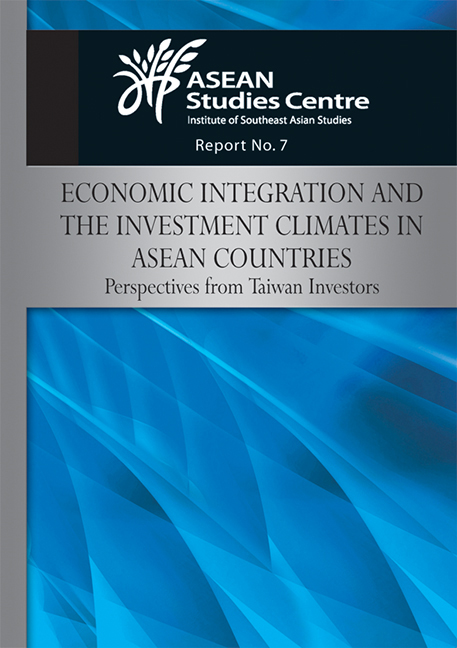 Economic Integration and the Investment Climates in ASEAN Countries
Economic Integration and the Investment Climates in ASEAN Countries Book contents
- Frontmatter
- Contents
- Introduction
- I Economic Integration and the Investment Climates in ASEAN Countries: Perspectives from Taiwan Investors
- Background of the Symposium
- Opening Remarks
- Session 1
- Session 2
- Session 3
- Questions and Answers
- Conclusion and Policy Suggestions
- II Background Papers
- Annex I: Programme of the Symposium
Session 1
from I - Economic Integration and the Investment Climates in ASEAN Countries: Perspectives from Taiwan Investors
Published online by Cambridge University Press: 21 October 2015
- Frontmatter
- Contents
- Introduction
- I Economic Integration and the Investment Climates in ASEAN Countries: Perspectives from Taiwan Investors
- Background of the Symposium
- Opening Remarks
- Session 1
- Session 2
- Session 3
- Questions and Answers
- Conclusion and Policy Suggestions
- II Background Papers
- Annex I: Programme of the Symposium
Summary
6. The first speaker of Session 1, Dr Chao-Jen Huang, Director, Research Division of Southeast Asia, TIER, discussed the economic interactions between ASEAN and Taiwan since the late 1980s. He also examined the economic impact of East Asian economic integration on the assumption that Taiwan joined the scheme.
7. He asserted that East Asian regionalism was necessary to cope with the threats of globalization. Signing bilateral FTAs among East Asian nations was a natural way of promoting economic integration. Hence, ASEAN and Taiwan needed to form an economic cooperative unit to enhance economic efficiency and political power.
8. It was found that, while Taiwan, with its relative superiority in technology and capital, was in a leading position for industrialization, ASEAN-5, with its rich natural resources, cheap labour and 600 billion population, was better placed in the labour-intensive industries and the services sector.
9. The characteristics of Taiwan's foreign direct investment (FDI) in Southeast Asia depicted the structure of economic relations between the two. In the late 1980s, Taiwan enterprises decided to relocate their manufacturing operations to Southeast Asia, where there was cheap labour and rich natural resources. Taiwan's FDI in Southeast Asia increased sharply from US$8.1 million in 1986 to US$2.1 billion in 2007. As a proportion of total Taiwanese outbound FDI, the share of ASEAN hit a high of 43.5 per cent in 1991. Thereafter, it went down, a process accelerated by the 1997– 98 financial crisis. On the other hand, Taiwan investment flows to the world increased, mainly to mainland China. However, by 2004, because of high natural resource prices and to diversify investments, Taiwanese investors again started looking at Southeast Asia.
10. Before 1987, Taiwan's FDI in Southeast Asia was mainly centred in Indonesia and Thailand. By 1993, it had moved to Vietnam, taking advantage of the deregulation reforms happening in that country. In 1952–2007, most of Taiwan's FDI went to the electronic and electrical industry (41 per cent), followed by textiles (20 per cent) and chemicals (5 per cent).
- Type
- Chapter
- Information
- Economic Integration and the Investment Climates in ASEAN CountriesPerspectives from Taiwan Investors, pp. 5 - 8Publisher: ISEAS–Yusof Ishak InstitutePrint publication year: 2009
